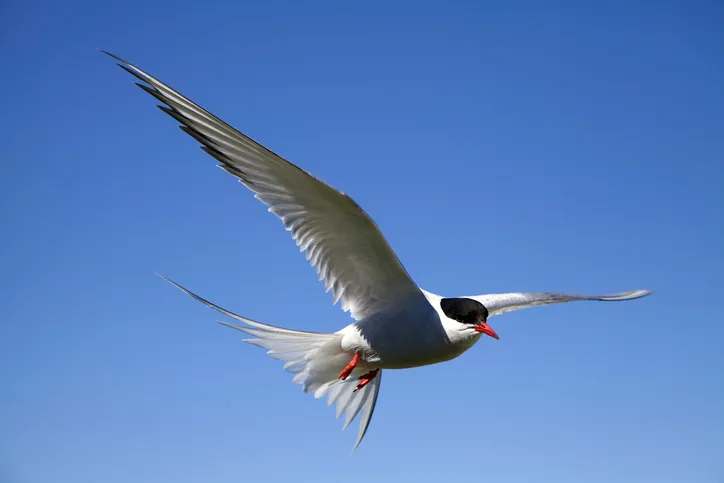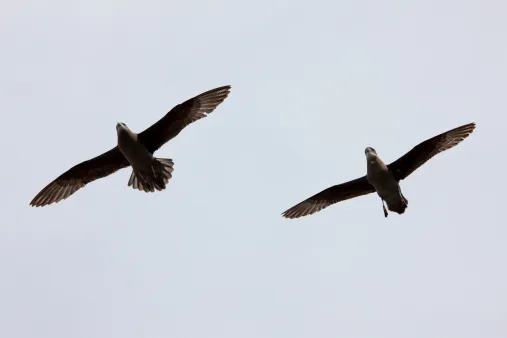Modern electronic devices have transformed our knowledge of the lives of birds at sea. The findings are showcased in a new book Far from Land – The Mysterious Lives of Seabirds by Michael Brooke who here reports some of the more amazing discoveries.
1
Arctic Terns

For many decades it has been known that few creatures on Planet Earth enjoy more daylight per year than Arctic Terns. They breed at high latitude colonies (in the northern hemisphere), some sufficiently far north to enjoy summertime midnight Sun. Then the birds head south to pass the northern winter off Antarctica; perhaps not in perpetual daylight but certainly where darkness prevails for only a few hours per night.
In the case of birds breeding in, say, Greenland or Scotland, the journey south does not stray beyond the Atlantic. But the southward route taken by Alaskan birds is far more surprising. Initially they head south along the western seaboard of the Americas, with brief stopovers off Oregon and then off Ecuador. Pressing further south, they do not go all the way to Cape Horn. Instead, at around 40oS, they turn left to cross the Andes at an altitude of up to 1,500m and then Argentinian Patagonia, in temporary denial of their name of ‘sea swallows’. By this unexpected route, Alaskan Arctic Terns reach the South Atlantic where they pass the northern winter.
2
Murphy’s Petrels

In praise of Murphy’s might sound like an anthem sung too loudly in celebration of an Irish bar. It might also be the reaction of anyone fortunate enough to have studied Murphy’s Petrels at their South Pacific colonies.
The study needs time spent on the uninhabited islands of the Pitcairn group, complete with blue lagoons, picturesquely-angled coconut palms, and a delightful absence of pesky biting insects. Then there are the petrels themselves; mid-sized birds of a soft pearl-grey colour and an equally soft temperament. Laying their eggs on the ground in open forest behind the beach, they are wonderfully tolerant of a researcher’s intrusion.
An egg can be removed, measured, and replaced, with one’s hand receiving a gentle nibble of thanks. A bird can be plucked off the egg and a 3g tracking device attached to its leg, before it resumes incubation ahead of the journey it will make when the mate returns and sits in turn.
And what a journey! Around half the birds venture around 1,500 km south of Henderson Island, the site of most research work. The other half proceed on a vast anti-clockwise loop that extends, on average, over 13,700 km and takes the birds up to 4,800 km from home. The most distant point of these travels is roughly north-east of Henderson and therefore nearly within the Exclusive Economic Zones of Peru or Chile. By proceeding anti-clockwise, the birds benefit from westerly tail winds on the outward journey, and easterlies nearer the Equator when making for home.
The reason for these two journey types remains to be identified. Indeed in the first 24 hours of a trip, birds on both trajectories cover a similar distance in a similar direction, roughly south. Perhaps they set forth from Henderson not knowing their eventual destination!
3
Puffins

A consistent feature of the tracking studies of seabirds is how consistent the movements of individual birds are. This is certainly true of Atlantic Puffins.
In long summer days Puffins swarm in their thousands around the near mythical islands of the far north – St. Kilda, Fair Isle, Sule Skerry. But then the colonies empty and the question arises ‘Where have the Puffins gone?’ Until a few years ago, the answer was a rather uninformative ‘Out to sea’.
Particularly for the Puffins breeding on Skomer Island, off the Pembrokeshire coast, a far more nuanced answer is now available. There are some individuals that move briskly west after leaving Skomer, almost reaching Newfoundland. Then, in late autumn, they head north towards Iceland before steadily making progress back to Skomer in the early calendar months of the year. Other stay in (relatively) local waters, going no further west than western Ireland and the Bay of Biscay.
In general the non-breeding travels of an individual Puffin are remarkably similar from one year to the next, but different from those of many of its fellow Puffins. However it is not very obvious what, if any, are the advantages of one movement pattern, compared to another. Perhaps, over the decade of a breeding Puffin’s life, one pattern is as good as any other. Still undiscovered is the age at which a Puffin becomes set in its wintering ways.
4
Brűnnich’s Guillemots

Most breeding seabirds remain faithful to the same mate from one year to the next. Consequently researchers routinely record pairs that have remained intact for several years, and sometimes more than a decade. Given such admirable fidelity, do the pairs remain together outside the breeding season. It is a pleasingly romantic thought. Think Kate Winslet and Leonardo DiCaprio clinging to the Titanic’s floating wood panelling, before DiCaprio chills to his death. Alas, there is no evidence to confirm such non-breeding togetherness in seabirds.
Of course, maintaining contact amid howling winds and stormy seas would not be easy, and might not deliver tangible benefits to capable adult birds. But what about young birds still learning to fend for themselves? Then the benefits of prolonged association with a parent could be substantial and, in a handful of species, this happens. Young Caspian Terns remain with their parents on an autumnal Pacific journey from Washington State south to Acapulco, Mexico. Since the terns probably mostly roost ashore at night, this link between parent and youngster seems plausible.
Scarcely imaginable is the 3,000 km journey south from Greenland made by a male Brűnnich’s Guillemot – and it always is the father – and his chick. Throughout this journey that is made by swimming - since the young bird certainly remains incapable of flight - the father feeds his charge. Probably contact is maintained by a combination of sight and call. But there must be occasions when the juvenile, encountering a seething maelstrom of salt spray for the first time, is terrified of losing contact with his lifeline, his father.
5
Wandering Albatrosses

It is almost belittling to describe so wondrous a bird as the Wandering Albatross as a workhorse. Yet the Wandering Albatross has arguably been the workhorse of seabird tracking studies. There are two reasons: the ease with which birds can be caught at the colony and their large size. The advantage of the latter, up to 10 kg, is that relatively large devices can be attached. Indeed Wanderers were the subjects of the first successful satellite tracking of seabirds at sea. This was achieved about 30 years using 180g transmitters, laughably chunky by today’s standards.
Generally female Wandering Albatrosses forage to the north of males in the Southern Ocean where French researchers have been at the forefront. They have shown that males, but not females, tend to forage still further south as they age. They shift southward from the Roaring Forties to the Furious Fifties. A male aged 40, by no means exceptional, will routinely encounter icebergs.
French research, based at the sub-Antarctic Kerguelen Islands, has also revealed intriguing consistency among the Wandering Albatrosses that recalls the consistent wanderings of Atlantic Puffins. Wandering Albatrosses breed only every second year. When not breeding, some birds remain more or less in the region of Kerguelen in the southern Indian Ocean. Others repeatedly circumnavigate the globe. Once a bird has adopted one habit, it apparently sticks with it for the remainder of its long life. Better the devil you know?
Underwater behaviour

Devices attached to diving seabirds have generated an astonishingly detailed picture of the birds’ underwater activity. First, and most obviously, depth recorders record the depths plumbed, and plumb’s the word for Emperor Penguins, which occasionally reach a depth in excess of 500 m.
Attached accelerometers yield further information on a bird’s acceleration in the three perpendicular axes. Combine the data with those from depth recorders and it becomes possible to infer that diving Guillemots undertake two broad categories of dive. Those with a V-shaped profile take the bird to a maximum depth from which it ascends directly. Alternatively the dive can have a U-shaped profile, the bird lingering at its maximum depth. During the bottom phase of the U-shaped dives of Magellanic Penguins, there are clear ‘wiggles’ (the technical term!) indicating quick turns almost certainly linked to catching a prey item.
My favourite finding concerns Emperor Penguins, which frequently leap from the water onto floating sea ice. The shame associated with not leaping high enough and splattering back into the water is considerable, not to mention the risk from predatory leopard seals. This means it would be prudent for the penguin to adjust its exit speed according to the anticipated height of the ice cliff.
Now a considerable proportion of the upward acceleration of an ascending penguin is due to the expansion of air trapped within the plumage. This expansion creates ever-greater buoyancy until eventually the bird pops, cork-like, to the surface. And the greater the depth at which the ascent starts, the greater the exit speed. Accordingly, Emperor Penguins, presumably with the benefit of prior experience, begin their underwater ascent from a greater depth, the higher the ice cliff to be surmounted.
Far from Land – The Mysterious Lives of Seabirds by Michael Brooke is available now (£24, Princeton University Press)
Follow Science Focus onTwitter,Facebook, Instagramand Flipboard